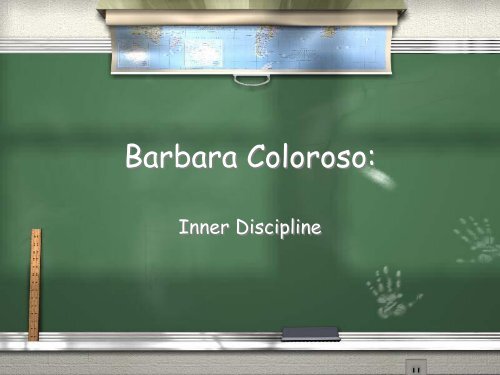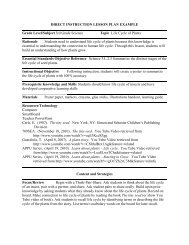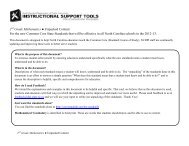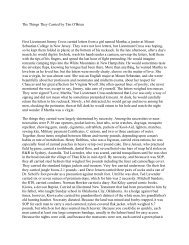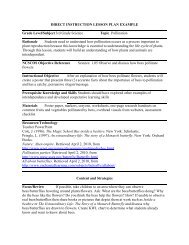Barbara Coloroso:
Barbara Coloroso:
Barbara Coloroso:
You also want an ePaper? Increase the reach of your titles
YUMPU automatically turns print PDFs into web optimized ePapers that Google loves.
<strong>Barbara</strong> <strong>Coloroso</strong>:<br />
Inner Discipline
<strong>Barbara</strong> <strong>Coloroso</strong> is…<br />
An internationally recognized speaker and<br />
author in the areas of parenting, teaching,<br />
school discipline, non-violent conflict<br />
resolution, and reconcilatory justice<br />
And educational consultant for school<br />
districts
Also…<br />
She has also been a<br />
teacher, a<br />
laboratory school<br />
instructor, and a<br />
university<br />
instructor<br />
She has written 2<br />
international bestsellers:<br />
Kids are<br />
Worth It! Giving<br />
Children the Gift of<br />
Inner Discipline and<br />
Parenting Through<br />
Crisis: Helping Kids in<br />
Times of Loss, Grief,<br />
and Change
<strong>Coloroso</strong> believes that…<br />
Educators should work with<br />
students to help them<br />
develop inner discipline,<br />
which is the ability to<br />
behave creatively,<br />
constructively,<br />
cooperatively, and<br />
responsibly without being<br />
directed by someone else
<strong>Coloroso</strong> Suggests 3 Philsophical Stances<br />
That She Thinks are Essential to Teaching<br />
Inner Discipline:<br />
Discipline vs. Punishment<br />
Assertive Confrontation<br />
Consequences: Natural and<br />
Reasonable
Discipline vs. Punishment<br />
Punishment is adult<br />
oriented, imposes power,<br />
arouses anger and<br />
resentment, and invites<br />
more conflict.<br />
Punishment discourages<br />
students from<br />
acknowledging their actions<br />
because they might deny<br />
doing the behavior or place<br />
blame on anything or<br />
anybody other than<br />
themselves.<br />
Punishment leaves control<br />
in the teacher’s hands and<br />
gives students the message<br />
that the teacher is all<br />
powerful, accepts<br />
responsibility for student’s<br />
behavior and negates the<br />
need for students to<br />
develop Inner Discipline.
Discipline Does 4 Things That<br />
Punishment Cannot Do:<br />
It shows students what they should have<br />
done<br />
It gives them as much ownership of the<br />
problem as they are able to handle<br />
It gives them options for solving the<br />
problem<br />
It leaves their dignity intact
Discipline…<br />
Discipline deals with the reality of the<br />
situation rather than the power and the<br />
control of the adult. Students can change<br />
their attitudes and habits they might have<br />
led to the misbehavior. Therefore there<br />
would be a more peaceful classroom and<br />
school.
Assertive Confrontation<br />
Teachers must use caution to avoid<br />
endless arguments that waste a great<br />
deal of energy, lead to additional and<br />
more heated arguments, and solve<br />
nothing.
7 Rules for a Fair Fight and Effective,<br />
Assertive Confrontation<br />
When you are angry and<br />
upset, speak the message<br />
in a straightforward,<br />
assertive manner- not<br />
aggressively or passively.<br />
Tell the other person about<br />
your feelings.<br />
State your belief but avoid<br />
destructive words that<br />
attack another person.<br />
Give direct feedback. Tell<br />
the person the problem and<br />
how you feel about the<br />
problem.<br />
State what you want from<br />
the other person.<br />
Be open to the other<br />
person’s perspective on the<br />
situation.<br />
Negotiate an agreement<br />
you can both accept.
Consequences: Natural and<br />
Reasonable<br />
Natural consequences involve realworld<br />
consequences or interventions<br />
and deal with the reality of the<br />
situation rather than the power and<br />
control of the adult.
A Natural Consequence:<br />
For example…if a student refuses to<br />
wear a coat outside, the natural<br />
consequence is that he will be cold.<br />
Consequences such as these are<br />
learned without nagging, warning, and<br />
reminding
If the natural consequence is<br />
unreasonable or would be<br />
inappropriate…<br />
Use a reasonable consequence.<br />
Natural consequences just happen, but<br />
reasonable consequences require reasoning<br />
and planning. A key point in determining<br />
reasonable consequences is for the teacher<br />
to ask whether the goal is to teach the<br />
student or punish the student.
Behaviors and Misbehaviors<br />
Acceptable behavior is anything that<br />
is deemed socially responsible.<br />
Teachers should try to instill<br />
intrinsic motivation to do the right<br />
thing, so students will behave in a<br />
socially responsible way because they<br />
want to, not out of fear.
Establishing rules is one area where<br />
teachers can help students build a<br />
commitment to being good classroom<br />
citizens. When students help<br />
determine classroom rules, they take<br />
ownership of them, many experts<br />
contend.
Acceptable Behavior<br />
<strong>Coloroso</strong> believes teachers should<br />
uphold four classroom rules in the<br />
early grades: be on time; be prepared;<br />
do your assignments; and respect<br />
your own and others' life space.
Misbehavior<br />
Perhaps the biggest classroommanagement<br />
challenge teachers face<br />
is deciding how to respond when a<br />
student breaks the rules.
Misbehaviors<br />
For minor off-task<br />
behavior, teachers can use<br />
prompting such as eye<br />
contact, a friendly touch,<br />
or walking closer to give<br />
the student a chance to<br />
says "oops" and change her<br />
behavior. If the student<br />
does "self-correct," the<br />
teacher should thank her.<br />
<br />
When interventions are<br />
necessary, teachers should<br />
discipline in private, in a nonthreatening<br />
way. They should get<br />
close to the student, make eye<br />
contact, and whisper. Let the<br />
student know the behavior is<br />
unacceptable, he says, but also<br />
suggest a way to improve. The<br />
teacher might say, for example,<br />
"I'd like to get you to stop<br />
without embarrassing you in front<br />
of the class. What are some<br />
gestures I could use to help you<br />
remind yourself"
Implications for Diversity<br />
Inner discipline places a lot of the<br />
responsibility on the student, rather<br />
than the teacher.<br />
Teachers should allow students to<br />
have input on making classroom rules<br />
and identifying acceptable behaviors<br />
and misbehaviors
In a diverse classroom…<br />
The teacher should take into account how<br />
the student might view discipline at home<br />
or in his or her culture.<br />
The teacher should allow the student to<br />
make his or her own mistakes, and see for<br />
themselves how socially unacceptable<br />
behavior might be viewed by the public
The teacher can…<br />
Allow the student to share<br />
acceptable behaviors in his or her<br />
culture; what is viewed as a<br />
misbehavior to the teacher may not<br />
be a misbehavior to the student<br />
Give students the chance to give<br />
acceptable, reasonable consequences
Rewards<br />
Manipulative tactics such as<br />
rewards, bribes, and threats<br />
should not be used. <strong>Coloroso</strong><br />
believes that students should<br />
be empowered to trust in<br />
themselves and to learn selfdiscipline.<br />
The teacher’s duty<br />
is to give critical life<br />
messages such as “I believe in<br />
you,” “I trust you,” “I know<br />
you can handle this,” “You are<br />
listened to,” You are cared<br />
for,” You are very important<br />
to me.”<br />
Rewards also send the<br />
wrong message that<br />
kindness and positive<br />
behavior can be bought<br />
and bartered. Students<br />
who are bribed and<br />
rewarded constantly will<br />
often start to ask<br />
questions such as “What’s<br />
in it for me” “What’s the<br />
payoff” etc.
Rewards<br />
Rather than use monetary or tangible<br />
rewards, or even use praise, teachers<br />
should show appreciation for their<br />
students<br />
Example: “[Student], thanks for your<br />
fine work on the mathematics test.”
Consequences<br />
Consequences should be RSVP…reasonable,<br />
simple, valuable, and practical<br />
Example: If a student breaks a glass, it<br />
wouldn’t be reasonable to ask him to pick<br />
up the small slivers of glass; it would be<br />
reasonable for him to hold the bag while<br />
the teacher picks up the small slivers of<br />
glass
Natural Consequences<br />
Certain consequences are just associated<br />
with the real world, and can help a student<br />
learn without nagging or reminding.<br />
Such as the example stated earlier…if a<br />
student refuses to wear a coat outside<br />
when it’s cold, the natural consequence is<br />
that the student will be cold
Pros of this Model<br />
It is humanistic and focuses on preserving<br />
dignity and a sense of self-worth<br />
Students, not the teacher, accept<br />
ownership of the problem<br />
Cost-effective; teachers don’t have to<br />
spend money on rewards; rather, teachers<br />
merely need to show appreciation for their<br />
students
More pros<br />
This model follows the Golden Rule; adults<br />
should treat students how they themselves<br />
would want to be treated<br />
If followed correctly, students will have<br />
intrinsic motivation to want to do the right<br />
thing and accept in socially acceptable<br />
ways.<br />
If followed correctly, it should lead to a<br />
more peaceful classroom
Cons of This Model<br />
Lack of rewards may make this model hard<br />
to take effect; rewards can help wanted<br />
behavior establish itself more quickly<br />
Success with Inner Discipline requires a<br />
certain kind of person; “brickwall” or<br />
“jellyfish” teachers will experience<br />
difficulty as they try to establish this<br />
model
Classroom Applications<br />
Allow students to come up with<br />
logical consequences for<br />
misbehaviors.<br />
Example: If a student accidentally<br />
breaks an object at a museum, the<br />
student can apologize to the museum,<br />
and write an apology letter to the<br />
teacher explaining how he will handle his<br />
hands and feet on future trips
Classroom Applications<br />
If a natural consequence isn’t life<br />
threatening, let the student<br />
experience them<br />
Example: If a student decides to swing<br />
his arms around while walking in line, and<br />
that student hits his arm on a wall, he<br />
will hopefully be less likely to do that a<br />
second time
Scenario<br />
While outside for recess, the<br />
teacher reminds her students of ways<br />
to be safe while on the playground. A<br />
student decides he wants to jump off<br />
the swings, which goes against his<br />
teacher’s suggestions. How should<br />
the teacher handle this
Resources<br />
For more information about <strong>Barbara</strong> <strong>Coloroso</strong> and<br />
Inner Discipline, you can check out:<br />
Discipline Models: Inner Discipline:<br />
http://www.metu.edu.tr/~e133376/project/Inner%<br />
20Discipline.htm<br />
Education Update: September 1996, Volume 38,<br />
Number 6, “Managing Today’s Classroom: Finding<br />
Alternatives to Control and Compliance” by Scott<br />
Willis<br />
Mr. Roger’s Neighborhood: Article for Teachers:<br />
http://pbskids.org/rogers//parentsteachers/theme<br />
/1491_t_art.html


